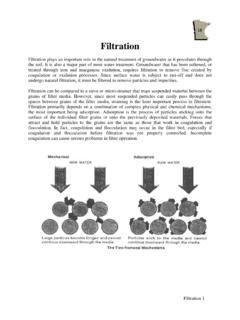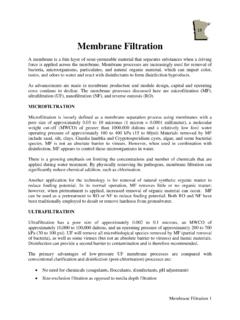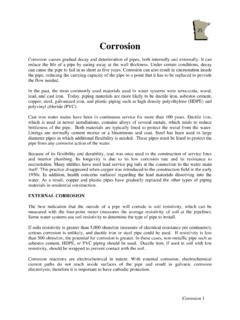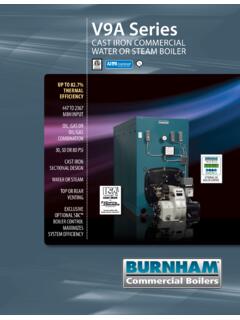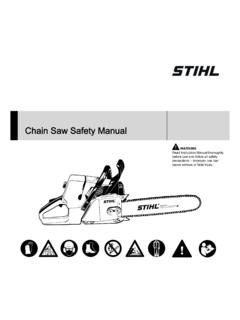Transcription of AERATION - MRWA
1 AERATION 1 AERATION AERATION brings water and air in close contact in order to remove dissolved gases (such as carbon dioxide) and oxidizes dissolved metals such as iron, hydrogen sulfide, and volatile organic chemicals (VOCs). AERATION is often the first major process at the treatment plant. During AERATION , constituents are removed or modified before they can interfere with the treatment processes. AERATION brings water and air in close contact by exposing drops or thin sheets of water to the air or by introducing small bubbles of air (the smaller the bubble, the better) and letting them rise through the water. The scrubbing process caused by the turbulence of AERATION physically removes dissolved gases from solution and allows them to escape into the surrounding air. AERATION also helps remove dissolved metals through oxidation, the chemical combination of oxygen from the air with certain undesirable metals in the water.
2 Once oxidized, these chemicals fall out of solution and become particles in the water and can be removed by filtration or flotation. The efficiency of AERATION depends on the amount of surface contact between air and water, which is controlled primarily by the size of the water drop or air bubble. Oxygen is added to water through AERATION and can increase the palpability of water by removing the flat taste. The amount of oxygen the water can hold depends primarily on the temperature of the water. (The colder the water, the more oxygen the water can hold). Water that contains excessive amounts of oxygen can become very corrosive. Excessive oxygen can also cause problems in the treatment plant air binding of filters. CHEMICALS REMOVED OR OXIDIZED BY AERATION Constituents commonly affected by AERATION are: Volatile organic chemicals, such as benzene (found in gasoline), or trichloroethylene, dichloroethylene, and perchloroethylene (used in dry-cleaning or industrial processes) Ammonia Chlorine Carbon dioxide Hydrogen sulfide Methane Iron and Manganese AERATION 2 Carbon Dioxide Surface waters have low carbon dioxide content, generally in the range of 0 to 2 mg/l.
3 Water from a deep lake or reservoir can have high carbon dioxide content due to the respiration of microscopic animals and lack of abundant plant growth at the lake bottom. Concentration of carbon dioxide varies widely in groundwater, but the levels are usually higher than in surface water. Water from a deep well normally contains less than 50 mg/l, but a shallow well can have a much higher level, up to 50 to 300 mg/l. Excessive amounts of carbon dioxide (above 5-15 mg/L) in raw water can cause three operating problems: Increases the acidity of the water, making it corrosive. Carbon dioxide forms a weak acid, H2C03 (carbonic acid). Tends to keep iron in solution, thus making iron removal more difficult. Reacts with lime added to soften water, causing an increase in the amount of lime needed for the softening reaction. Most aerators can remove carbon dioxide by the physical scrubbing or sweeping action caused by turbulence.
4 At normal water temperatures, AERATION can reduce the carbon dioxide content of the water to as little as mg/l. Hydrogen Sulfide Hydrogen sulfide can present dangerous problems in water treatment. Brief exposures (less than 30 minutes) to hydrogen sulfide can be fatal if the gas is breathed in concentrations as low as percent by volume in the air. The Immediate Dangerous to Life and Health level for hydrogen sulfide is 300 ppm. Hydrogen sulfide occurs mainly in groundwater supplies, and may be caused by the action of iron or sulphur reducing bacteria in the well. The rotten-egg odor often noticed in well waters is caused by hydrogen sulfide. Hydrogen sulfide in a water supply will disagreeably alter the taste of coffee, tea, and ice. Occasional disinfection of the well can reduce the bacteria producing the hydrogen sulfide. Serious operational problems occur when the water contains even small amounts of hydrogen sulfide: Disinfection of the water can become less effective because of chlorine demand exerted by the hydrogen sulfide.
5 Corrosion to piping systems and the water tanks, water heaters , and copper alloys. AERATION 3 AERATION is the most common choice for removal of hydrogen sulfide from water. Hydrogen sulfide has a low boiling point and vaporizes easily. The turbulence from the aerator will easily displace the gas from the water; however the designer of the system needs to consider how the gas is discharged from the aerator. If the gas accumulates directly above the water, the process will be slowed and corrosive conditions can be created. Methane Methane is a colorless gas that is highly flammable and explosive and can be found in groundwater. It may be formed by the decomposition of organic matter. It can be found in water from aquifers that are near natural-gas deposits. Methane tends to make the water taste like garlic. The gas is only slightly soluble in water, has a low boiling point, vaporizes easily, and therefore is easily removed by the AERATION of the water.
6 Iron and Manganese Iron and manganese minerals are commonly found in soil and rock and can dissolve into groundwater as it percolates through soil and rock. Water containing more than mg/l of iron will cause yellow to reddish-brown stains of plumbing fixtures or almost anything that it contacts. If the concentration exceeds 1 mg/l, the taste of the water will be metallic and the water may be turbid. Manganese in water, even at levels as low as mg/l, will cause blackish staining of fixtures and anything else it contacts. Manganese concentration levels that can cause problems are mg/l and above. If the water contains both iron and manganese, staining could vary from dark brown to black. Typical consumer complaints are that laundry is stained and that the water is red or dirty. Water containing iron and manganese should not be aerated unless filtration is provided.
7 Oils and Algae By-Products Many taste and odor problems in surface water could be caused by oils and by-products that algae produce. Since oils are much less volatile than gases, AERATION is only partially effective in removing them. TYPES OF AERATORS Aerators fall into two categories. They either introduce air to water, or water to air. The water-in-air method is designed to produce small drops of water that fall through the air. The air-in-water method creates small bubbles of air that are injected into the water stream. All aerators are designed to create a greater amount of contact between air and water to enhance the transfer of gases and increase oxidation. AERATION 4 Water-Into-Air Aerators Cascade Aerators A cascade aerator (one of the oldest and most common aeratrors) consists of a series of steps that the water flows over (similar to a flowing stream). In all cascade aerators, AERATION is accomplished in the splash zones.
8 Splash zones are created by placing blocks across the incline. (They are the oldest and most common type of aerators.) Cascade aerators can be used to oxidize iron and to partially reduce dissolved gases. Cone Aerators Cone aerators are used primarily to oxidize iron and manganese from the ferrous state to the ferric state prior to filtration. The design of the aerator is similar to the cascade type, with the water being pumped to the top of the cones and then being allowed to cascade down through the aerator. Slat and Coke Aerators Slat and coke trays are similar to the cascade and cone aerators. They usually consist of three-to-five stacked trays, which have spaced wooden slats in them. The trays are then filled with fist-sized pieces of coke, rock, ceramic balls, limestone, or other materials. The primary purpose of the materials is providing additional surface contact area between the air and water.
9 Draft Aerators Draft aerators are similar to other water-into-air aerators, except that the air is induced by a blower. There are two basic type of draft aerators. One has external blowers mounted at the bottom of the tower to induce air from the bottom of the tower. Water is pumped to the top and allowed to cascade down through the rising air. The other, an induced-draft aerator, has a top-mounted blower forcing air from bottom vents up through the unit to the top. Both types are effective in oxidizing iron and manganese before filtration. AERATION 5 Spray Aerators Spray aerators have one or more spray nozzles connected to a pipe manifold. Water moves through the pipe under pressure, and leaves each nozzle in a fine spray and falls through the surrounding air, creating a fountain affect. Spray AERATION is successful in oxidizing iron and manganese and increases the dissolved oxygen in the water.
10 Air-Into-Water Aerators Pressure Aerators There are two basic types of pressure aerators. One uses a pressure vessel; where water to be treated is sprayed into high-pressure air, allowing the water to quickly pick up dissolved oxygen. The other is a pressure aerator commonly used in pressure filtration Air is injected into the raw water piping and allowed to stream into the water as a fine bubble, causing the iron to be readily oxidized. The higher the pressure, the more readily the transfer of the oxygen to the water. The more oxygen that is available, the more readily the oxidation of the iron or manganese. Centrifugal Aerators Centrifugal aerators create enhanced conditions for dissolving gas into liquid phase, including bubble size, and bubble size distribution and duration of interaction with liquid.

